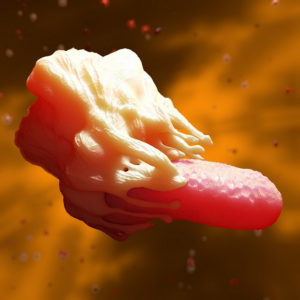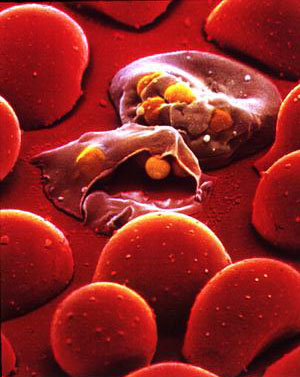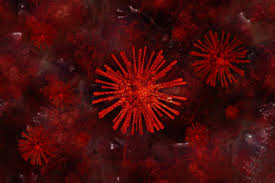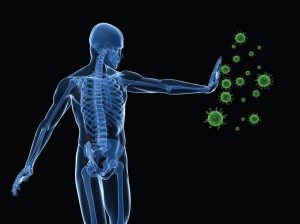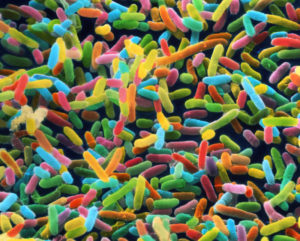About half a million people, most of them children living in Africa, are killed each year by malaria1. Management of malaria, particularly that caused by the highly virulent protozoan parasite Plasmodium falciparum, is challenged by the emergence of resistance to antimalarial drugs2. Writing in Nature, Kim et al.3 report the structure and molecular properties of a key protein that facilitates resistance, the P. falciparum chloroquine-resistance transporter (PfCRT). The structure reveals the consequences of finely tuned mutations of the amino-acid residues that line a crucial central cavity in PfCRT. These mutated residues allow resistant parasites to transport certain antimalarial drugs away from their site of action — and the effect of the mutations is different for closely related drugs.
Malaria parasites spend part of their life cycle inside human red blood cells. There, they use a specialized membrane-bound compartment known as the digestive vacuole to degrade the protein haemoglobin, thereby generating amino-acid building blocks for growth4. Haemoglobin digestion also produces a toxic side product called haem, which is exploited by antimalarials from the quinoline family of drugs (which includes chloroquine and piperaquine). These drugs bind to the released haem in the digestive vacuole and prevent the compound’s detoxification by the parasite — in effect, poisoning the parasite with its own metabolic debris4.
Chloroquine’s affordability, safety and efficacy made it the drug of choice for combating malaria, until widespread resistance developed in the 1980s. Piperaquine is a structurally related compound that retains activity against chloroquine-resistant parasites and is currently used in combination with another antimalarial drug, dihydroartemisinin. Unfortunately, resistance to piperaquine is now widespread in parts of southeast Asia5. Paradoxically, piperaquine-resistant parasites are often more sensitive to chloroquine than are piperaquine-sensitive parasites6.
Drug resistance can arise because of mutations either in the drug’s target or in biological machinery that transports the drug to or from the target. A landmark report7 in 2000 identified PfCRT as the main mediator of chloroquine resistance in P. falciparum. Resistance emerged independently at different locations around the world, but is always associated with a particular mutation in the transporter — the substitution of a lysine amino-acid residue by a threonine residue (a K76T mutation). K76T combines with other geographically specific PfCRT mutations to mediate resistance and improve the fitness of the mutant parasites6–8.
PfCRT is a member of the superfamily of proteins known as drug/metabolite transporters9 and is located in the membrane of the parasite’s digestive vacuole. Structural and biochemical studies of related proteins suggest that resistance to chloroquine arises as a result of the transporter passing chloroquine out of the digestive vacuole, thus removing it from its site of action8. Interestingly, piperaquine resistance emerges when parasites harbouring the K76T mutation acquire further mutations6.
Efforts to design new resistance-busting quinoline antimalarials have been stymied by a lack of information about the structures of mutated PfCRT. But in the past few years, advances in a technique called cryo-electron microscopy10 (cryo-EM) have revolutionized structural biology by enabling the direct imaging of membrane-embedded proteins, such as PfCRT, that are not amenable to study using X-ray crystallography. Kim et al. used single-particle cryo-EM to determine the structure of PfCRT in South American 7G8 parasites, which harbour mutations that confer high-level chloroquine resistance.
The authors first had to work out a protocol for efficiently expressing, purifying and reconstituting PfCRT into a membrane-like environment, to maintain a native conformation of the protein. PfCRT is relatively small (49 kilodaltons) compared with proteins that are typically studied using cryo-EM, and so Kim et al. prepared an antibody fragment (known as an antigen-binding fragment, or Fab) that binds to PfCRT, thereby forming a complex that has sufficient mass and stability to allow cryo-EM-based structural elucidation. This approach yielded a structure with 3.2-ångström resolution.
PfCRT was revealed to have ten transmembrane domains and a negatively charged central cavity. The cavity opens on to the digestive vacuole, but closes about halfway through the membrane. The Fab-bound cavity has an opening 25 Å in diameter, which is large enough to contain chloroquine (the maximum dimension of which is about 14 Å) and piperaquine (with a maximum dimension of about 21 Å). The structure shows that wild-type PfCRT has a positively charged lysine residue (K76) positioned in the cavity. This residue is thought to repel both chloroquine (which has two positive charges) and piperaquine (which has four positive charges), thereby trapping them in the digestive vacuole…
